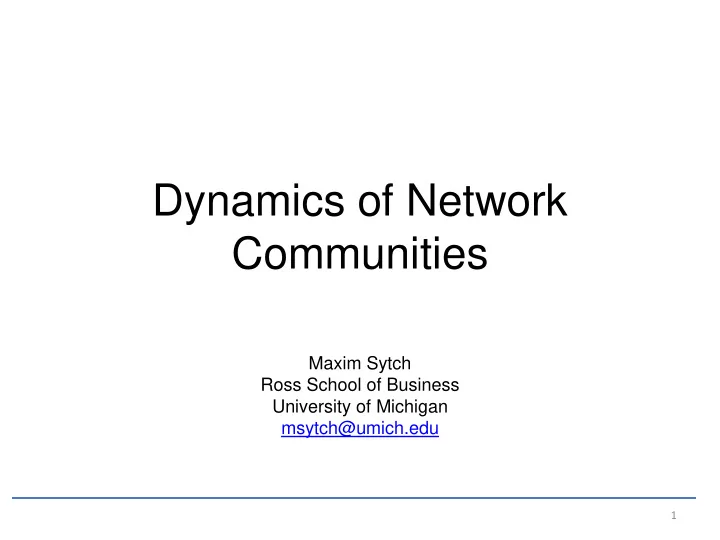

Dynamics of Network Communities Maxim Sytch Ross School of Business University of Michigan msytch@umich.edu 1
Network Communities (Global Computer Industry) 2
Dynamics of Network Communities and a Firm’s Invention • Interorganizational ties are instrumental for the diffusion of tacit knowledge, information, and other resources (3) global-network level (3) global-network level • Greater heterogeneity in knowledge and information between communities, rather than within communities - Homophilous selection (2) network-community level (2) network-community level - Homogenization • Knowledge and other resources in network communities are more accessible than more distant (1) ego-network level (1) ego-network level inputs - Shorter network distances - Multiple redundant pathways connecting residents - Lower transaction costs 3
1 ( C C ) / ( C C ) i t , 1 i t , i t , 1 i t , Membership Turnover & Movement Across Communities time t-1 time t 1 ( C C ) / ( C C ) i t , 1 i t , i t , 1 i t , 4
Community Membership Turnover and a Firm’s Invention 5 4.8 4.6 4.4 4.2 4 0 .2 .4 .6 .8 1 Membership turnover A typical member of a moderately dynamic community (i.e., one that retains about 55% of its members from year t-1 to t) tends to file for 19.5% more patents than a member of a static community (i.e., one that retains all of its members), and for 4.2% more patents than a member of a highly dynamic community (i.e., one that retains just 30% of its members). 5
Movement across Communities and a Firm’s Invention 8 7 6 5 4 3 0 1 2 3 4 5 6 7 8 9 Prior community affiliations A typical member of a moderately dynamic community (i.e., one that retains about 55% of its members from year t-1 to t) tends to file for 19.5% more patents than a member of a static community (i.e., one that retains all of its members), and for 4.2% more patents than a member of a highly dynamic community (i.e., one that retains just 30% of its members). A typical firm with a moderate rate of movement across different network communities (i.e., one with about 5 prior community affiliations) files for approximately twice as many patents as a firm with no prior community affiliations. It also files for about 50% more patents than a firm with 9 prior community affiliations. 6
Dynamics of Network Communities and a Firm’s Invention 5.5 8 5 6 4.5 4 4 2 Low coreness (mean - 1SD) Low avg. coreness (mean - 1SD) High coreness (mean + 1SD) High avg. coreness (mean + 1SD) 3.5 0 0 .2 .4 .6 .8 1 0 1 2 3 4 5 6 7 8 9 Membership turnover Prior community affiliations 7
Spanning Community Boundaries and Diffusion Diffusion Model: (a) No hoarding of knowledge (b) Probability of knowledge transfer: the existence of a network relationship between firms the level of familiarity and trust between them (fraction of ties linking them to the same third parties) (c) Network formation & diffusion (d) Outcome: scale of diffusion (% of adopters) 8
Spanning Community Boundaries and Diffusion Community Network Diffusion Model: (a) No hoarding of knowledge (b) Probability of knowledge transfer: the existence of a network relationship between firms the level of familiarity and trust between them (fraction of ties linking them to the same third parties) (c) Network formation & diffusion (d) Outcome: scale of diffusion (% of adopters) 9
Communities and Diffusion Clan Network Convention Network 10
Network Behaviors and Diffusion Clan network Community Network Convention Network 11
Transient Bridges BP Daihatsu Ube Industries Balkancar 12
Recommend
More recommend